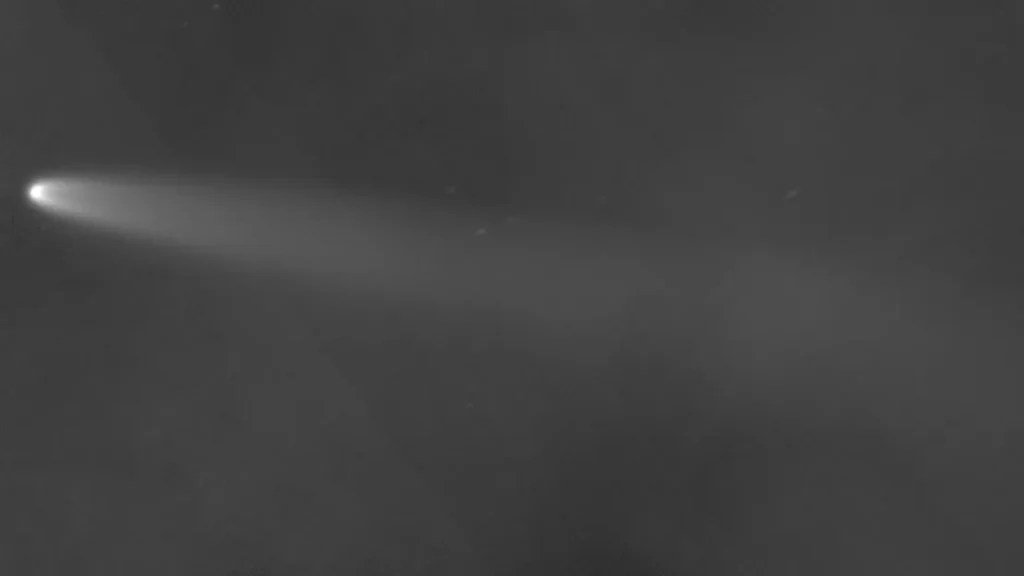The recently discovered comet, C/2023 A3 Tsuchinshan–ATLAS, is set to make a spectacular appearance in the night sky, reaching its closest point to Earth on October 12, 2024. This comet is particularly special because it was last visible around 80,000 years ago, during the time of the Neanderthals. Its return provides a once-in-a-lifetime opportunity for skywatchers and scientists alike to observe a celestial body that won’t be seen again for millennia.
The Significance of Comet C/2023 A3 Tsuchinshan–ATLAS
Comet Tsuchinshan–ATLAS has captivated the scientific community not only because of its rarity but also due to its sheer distance and size. When it makes its closest approach, it will still be about 44 million miles away from Earth. What sets this event apart is that the comet, which comes from the Oort Cloud (the farthest reaches of the solar system), was detected relatively recently—early in 2023—by both the Purple Mountain Observatory in China and the ATLAS project in South Africa.

Gianluca Masi/Virtual Telescope Project
This 80,000-year orbit underscores the uniqueness of the comet’s appearance in our skies. It would have last been visible during an era when the Earth was very different—Neanderthals roamed the planet, and human civilization was far from what we know today. Observing it today is like peering back into deep time, making its passage not just a cosmic event but also a historical one.
How to Observe the Comet
For those hoping to catch a glimpse of this rare comet, mid-October is the ideal time to look up. Tsuchinshan-ATLAS will be visible to those in the Northern Hemisphere, especially after sunset. Experts recommend watching the western part of the sky, using binoculars for the best possible view. With the naked eye, the comet will likely appear as a bright fireball with a long, striking tail. For those unable to see it in person, live streams like those provided by the Virtual Telescope Project will capture the moment of its closest approach.
This celestial event is unique because comets can be unpredictable. Initially, there were concerns that the comet might disintegrate as it passed close to the Sun on September 27. However, it appears that Tsuchinshan–ATLAS has remained intact and continues to brighten as it moves through the inner solar system. By mid-October, as it distances itself from the Sun, observers should be able to spot it more easily, assuming clear skies.
The Science Behind Comet Tsuchinshan–ATLAS
Comets are made up of ice, rock, and frozen gases, remnants from the early days of our solar system. Tsuchinshan–ATLAS, originating from the Oort Cloud, offers scientists a rare opportunity to study a visitor from the far reaches of our solar system. The Oort Cloud is a spherical region surrounding the Sun, filled with icy bodies that have remained largely unchanged since the formation of the solar system.
As the comet passes close to the Sun, sunlight reflects off its icy surface, creating its signature tail. This process, known as forward scattering, causes the comet to brighten dramatically, offering a spectacular sight in the night sky. Its proximity to the Sun and Earth means the tail of dust and gas will be especially prominent, making this a visually stunning event. The tail itself can stretch for millions of miles, and by measuring its composition, scientists can gather crucial data about the materials that existed in the early solar system.
Why This Comet Is So Important
Aside from its rarity, observing Comet Tsuchinshan–ATLAS holds tremendous scientific value. Since comets are essentially time capsules from the early solar system, they contain vital information about the conditions that existed when the planets formed. By studying its composition, scientists can gather data on the primordial materials that helped shape our cosmic neighborhood.
Furthermore, this comet’s journey offers insights into how comets interact with the gravitational forces of the solar system. There is always the possibility that gravitational interactions with other planets, particularly Jupiter, could alter the comet’s path, changing its orbit and preventing a future return. This makes this year’s appearance all the more critical, as it could be our last chance to study Tsuchinshan–ATLAS in detail.
Comets also play a significant role in delivering water and organic materials to planets. Some theories suggest that comets like Tsuchinshan–ATLAS may have contributed to the development of life on Earth by delivering essential materials billions of years ago. Observing this comet, therefore, allows scientists to test these hypotheses further and potentially uncover more about the origins of life in the solar system.
What the Future Holds for Skywatchers
Comet C/2023 A3 Tsuchinshan–ATLAS is not the only celestial event to look forward to this year. October 2024 is packed with exciting astronomical events, including the Hunter’s Moon and the Orionids meteor shower. However, the appearance of Tsuchinshan–ATLAS stands out as a highlight because of its historical and scientific significance. After October 12, the comet will continue to brighten, giving skywatchers multiple opportunities to observe it until early November.
Even as the comet begins to fade, other phenomena, such as the passage of Comet S1 (ATLAS) later in the month, will keep space enthusiasts engaged. But few events will match the rarity and grandeur of Tsuchinshan–ATLAS. Whether you are a casual observer or an experienced astronomer, this is an event that should not be missed.
Conclusion
The return of Comet C/2023 A3 Tsuchinshan–ATLAS after 80,000 years is a celestial event of enormous importance. Not only does it provide a spectacular show for skywatchers, but it also offers a unique opportunity for scientific study. Its origins in the Oort Cloud and its rare approach to Earth make it a valuable subject for astronomers, shedding light on the early solar system and the forces that shaped it.
This year’s close encounter with Comet Tsuchinshan–ATLAS invites everyone to marvel at the cosmos, reminding us of the rare and fleeting events that connect us with the past and offer a glimpse into the universe’s distant future.



















